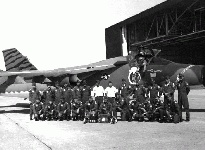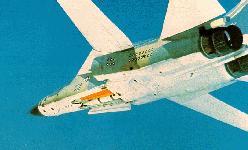





In December 1966, General Dynamics was awarded a contract to develop a strategic version of the F-111 fighter-bomber. The FB-111A was planned to replace the B-58 and to have the mission flexibility the B-58 lacked. The swing wing design was the key to meeting an Air Force requirement for a medium-range bomber capable of high- and low-altitude supersonic flight. The first flight occurred in July 1967 with the first production airplane delivered in August 1968. The F-111/FB-111, like the B-58 and XB-70 before it, had cost overrun problems and bad publicity. Of the planned 210 aircraft, only 76 were built. It was billed as an interim bomber to provide a better, low-level penetration capability until a B-52 replacement was built.
The FB-111A was a two-engine jet bomber with afterburner. Unlike prior strategic bombers, the engines are integral to the fuselage rather than pod-mounted. The variable geometry wings are attached high on the fuselage and can be swept back from 16 to 72.5. The crew consists of a pilot and a navigator sitting side by side in a cockpit that is designed as an emergency escape module.
With a maximum takeoff gross weight of 114,000 pounds, the FB-111A is 75.5 feet long, 17 feet high, and has a wing span of 34 feet with the wings fully swept or 70 feet with the wings forward. Unlike the fighter, the bomber version has a 3.5 foot extension on each wingtip for range improvement, additional avionics equipment, new engines, and a reinforced landing gear and fuselage to accommodate a heavier gross weight.
Although the range of the FB-111A is better than the fighter version (about 3,350 nm at high altitude cruise), it is still only a medium-range bomber that requires both additional tanker support and preferential basing. Due to its small size, there is little space for modification, thereby limiting adaptability and flexibility. For example, it is impossible to expand its ECM capability to counter new threats or to enhance its offensive avionics by adding new technology electronics. Like the B-58, most modifications must be a subsystem for subsystem replacement, which is expensive and requires tailored technology rather than allowing newer, off-the-shelf avionics. The incorporation of new avionics is further restricted by a weight limitation on the crew escape module.
There are, however, some advantages to the FB-111A over previous medium-range bombers. Its design is optimized for performance both at high and low altitude. It has a smaller RCS with a terrain following capability, making it a very effective low altitude penetrator. It also has an improved survivability due to its ability to get airborne quickly and away from its ground alert location. The two engines of the FB-111A can be started quickly, and it has a shorter takeoff roll than its predecessors. Further, the payload is not as limited as the B-58 since the FB-111A can carry up to 24 conventional bombs. However, this requires external carriage which restricts the wing sweep and degrades the range. The nuclear payload is two internal SRAM/gravity bombs and up to four external pylon-mounted weapons.
The combination of development cost overruns, bad publicity' high unit cost, and range/payload limitation stacked poorly in comparison to the B-52 and the new B-1 on the drawing boards. This resulted in the FB-111 program being scaled back. The FB-111 could adapt to different roles because mission flexibility was designed in, but its very size limited its range, modification space available, and payload. To overcome some of these drawbacks, SAC initiated several studies to stretch the FB-111A to improve its capabilities, but none resulted in a modification program. The modified design would have lengthened the existing FB-111A so as to increase fuel load capacity, space available for electronics, and internal and external weapons payload. The more powerful F-101 engine would have replaced the existing engines. It was estimated that the FB-111' s range would have been increased by about 1,200 nm by this modification and that the aircraft's total payload would have been increased to 15 nuclear weapons. New interest developed again in 1980 with the Long Range Combat Aircraft (LRCA) studies. FBl-111A and F-111D aircraft were examined for conversion to an FB-11lB/C version. Again, the fuselage was to be lengthened to allow fuel, payload, electronics, and engine thrust enhancement. This proposal was dropped when the Air Force chose a modified B-l for the LRCA over the FB-111B/C design. But it should be pointed out that even with these improvements, the FB-111 could not match the range or payload of the long-range B-52 or the B-1.
Specifications |
|



